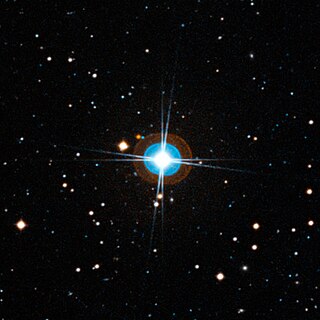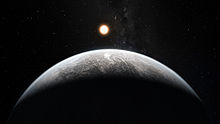Groombridge 1618 is a star in the northern constellation Ursa Major. With an apparent visual magnitude of +6.6, it lies at or below the threshold of stars visible to the naked eye for an average observer. It is relatively close to Earth, at 15.89 light-years (4.87 pc). This is a main sequence star of spectral type K7.5 Ve, having just 67% of the Sun's mass.
HD 210277 is a single star in the equatorial constellation of Aquarius. It has an apparent visual magnitude of 6.54, which makes it a challenge to view with the naked eye, but it is easily visible in binoculars. The star is located at a distance of 69.6 light years from the Sun based on parallax, but is drifting closer with a radial velocity of −20.9 km/s.
HD 28185 is a yellow dwarf star similar to the Sun located 128 light-years away from Earth in the constellation Eridanus. The designation HD 28185 refers to its entry in the Henry Draper catalogue. The star is known to possess one long-period extrasolar planet.

HD 219134 is a main-sequence star in the constellation of Cassiopeia. It is smaller and less luminous than the Sun, with a spectral class of K3V, which makes it an orange-hued star. HD 219134 is relatively close to our system, with an estimated distance of 21.34 light years. This star is close to the limit of apparent magnitude that can still be seen by the unaided eye. The limit is considered to be magnitude 6 for most observers. This star has a magnitude 9.4 optical companion at an angular separation of 106.6 arcseconds.

HD 192310 is a star in the southern constellation of Capricornus. It is located in the solar neighborhood at a distance of 28.7 light-years, and is within the range of luminosity needed to be viewed from the Earth with the unaided eye. HD 192310 is suspected of being a variable star, but this is unconfirmed.
HD 70642 is a star with an exoplanetary companion in the southern constellation of Puppis. It has an apparent visual magnitude of +7.17, which is too dim to be readily visible to the naked eye. The system is located at a distance of 95.5 light-years from the Sun based on parallax measurements, and is drifting further away with a radial velocity of +49.3 km/s. It came to within 55.3 ly of the Solar System some 329,000 years ago.

HD 40307 is an orange (K-type) main-sequence star located approximately 42 light-years away in the constellation of Pictor, taking its primary name from its Henry Draper Catalogue designation. It is calculated to be slightly less massive than the Sun. The star has six known planets, three discovered in 2008 and three more in 2012. One of them, HD 40307 g, is a potential super-Earth in the habitable zone, with an orbital period of about 200 days. This object might be capable of supporting liquid water on its surface, although much more information must be acquired before its habitability can be assessed.
HD 45364 is a star in the southern constellation of Canis Major. It is too faint to be visible to the naked eye, having an apparent visual magnitude of 8.08. The distance to this system is 112 light years based on parallax. It is drifting further away from the Sun with a radial velocity of +16.4 km/s, having come within 49 light-years some 1.5 million years ago.

HD 7924 is a single star located 55.5 light years away from the Sun in the northern constellation of Cassiopeia, near the northern constellation border with Cepheus. It has an orange hue and is only visible by means of binoculars or a telescope due to a low apparent visual magnitude of 7.167. The star is drifting closer to the Sun with a radial velocity of –22.7 km/s, and is expected to approach to within 9.3 light-years in around 711,700 years.
HD 190984, also known as HIP 99496, is a star located in the southern circumpolar constellation Pavo, the peacock. It has an apparent magnitude of 8.76, making it readily visible in small telescopes, but not to the naked eye. Based on parallax measurements from the Gaia spacecraft, the object is estimated to be 486 light years away from the Solar System. It appears to be receding with a heliocentric radial velocity of 20.3 km/s.
HD 85390 is a star with an exoplanet companion in the southern constellation of Vela. It was given the proper name Natasha by Zambia during the 100th anniversary of the IAU. Natasha means "thank you" in many languages of Zambia. This star is too faint to be seen with the naked eye, having an apparent visual magnitude of 8.54. It is located at a distance of 109 light years from the Sun based on parallax, and is drifting further away with a radial velocity of 33 km/s.
HD 90156 is a star with an orbiting exoplanet in the constellation Hydra. Based on parallax measurements, it is located at a distance of 71.6 light years from the Sun. The system is drifting further away with a heliocentric radial velocity of 27 km/s. The apparent visual magnitude of this star is 6.92, which is places it near the lower limit of visibility to the naked eye. A survey in 2015 ruled out the existence of any stellar companions at projected distances above 5 AU.
HD 164604 is a single star in the southern constellation of Sagittarius constellation. It has the proper name Pincoya, as selected in the NameExoWorlds campaign by Chile, during the 100th anniversary of the IAU. Pincoya is a female water spirit from southern Chilean mythology who is said to bring drowned sailors to the Caleuche so that they can live in the afterlife. A 2015 survey ruled out the existence of any additional stellar companions at projected distances from 13 to 340 astronomical units. It is known to host a single super-Jupiter exoplanet.

HD 10180, also designated 2MASS J01375356-6030414, is a Sun-like star in the southern constellation Hydrus that is notable for its large planetary system. Since its discovery, at least six exoplanets have been observed orbiting it, and some studies have proposed up to nine potential planets, which would make it potentially the largest of all known planetary systems, including the Solar System.
HIP 57050, or GJ 1148, is a faint star with two orbiting exoplanets in the northern constellation of Ursa Major. Other designations for this star include LHS 2443, G 122-40, and Ross 1003. From a distance of 36 light years based on parallax measurements, it is drifting closer to the Sun with a radial velocity of -9 km/s. This is a faint star with an absolute magnitude of 11.64. At the distance of HIP 57050, the apparent visual magnitude is 11.86, which is much too faint to be seen with the naked eye. HD 164595 has a high proper motion, traversing the celestial sphere at an angular rate of 0.577″ yr−1.

HD 189567 is a star with a pair of orbiting exoplanets, located in the southern constellation of Pavo. It is also known as Gliese 776, CD-67 2385, and HR 7644. The star has an apparent visual magnitude of 6.07, which is bright enough for it to be dimly visible to the naked eye. It lies at a distance of 58 light years from the Sun based on parallax measurements, but is drifting closer with a radial velocity of −10.5 km/s.
HD 39194 is a star located in the southern circumpolar constellation Mensa. It has an apparent magnitude of 8.07, making it readily visible in binoculars but not to the naked eye. The object is relatively close at a distance of 86 light years but is receding with a heliocentric radial velocity of 13.9 km/s.
HD 30669 is a yellowish-orange hued star located in the southern constellation Caelum, the chisel. It has an apparent magnitude of 9.11, making it readily visible in small telescopes but not to the naked eye. The object is relatively close at a distance of 188 light years, based on parallax measurements from Gaia DR3. Its distance from the Solar System is rapidly increasing, having a heliocentric radial velocity of 66 km/s.











